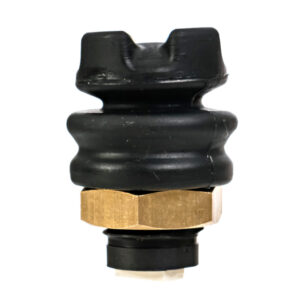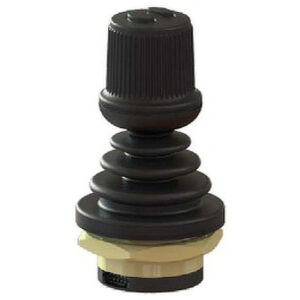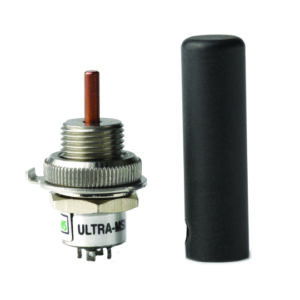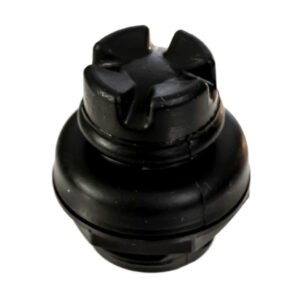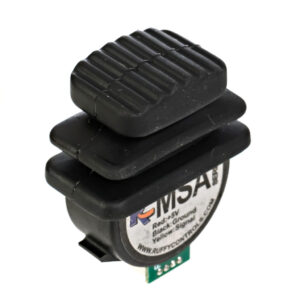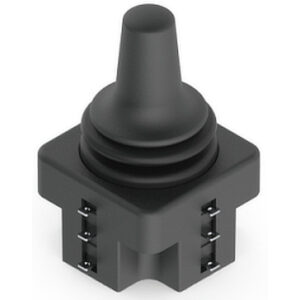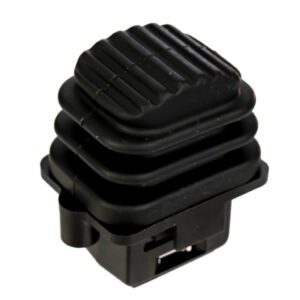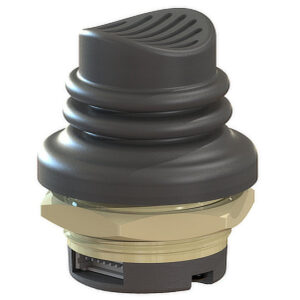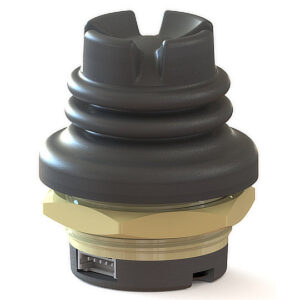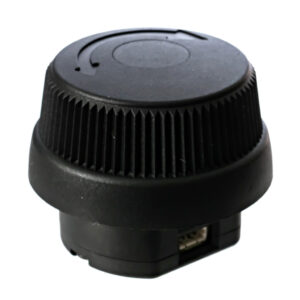Industrial Joysticks
We are proud to be able to offer a great range of industrial joysticks from Ruffy Controls and Ultra MSI. Through these dedicated manufacturers we are able to offer industry leading joysticks for use in Military, CCTV, Construction and Agricultural Vehicles, Conveyor systems, Robotics and ROV Control and Wheelchair Operation.
All the rugged industrial joysticks we supply use Hall Effect, Potentiometer or Force (strain gauge) functionality allowing for the greatest precision and control. Available from a mid-sized joystick with Z axis perfect for CCTV, Pan, Tilt, Zoom operation. All the way to the miniature 4-way figure joysticks ideal for panel and hand-held control devices.
Contact our knowledgeable sales team to discuss your exact requirements.
View Frequently Asked Questions about JoysticksTS2 Series – Hall Effect Finger Joystick
The TS2 series of hall effect finger joysticks from Ruffy Controls are micro finger joysticks with a handle height of around 17.7mm (0.7”). Available in a 2-axis configuration with choice of 2 open or 2 gated limiters and designed to fit cut outs of 12.6mm (0.495”) diameter. The TS2 series has a choice of round convex, round concaved, castle or flat single axis (Y) style caps. Electrically rated for a...
View ProductHE2 Series – Hall Effect Joystick
The HE2 Series of hall effect joysticks from Ruffy Controls are available in 2 or 3-axis with options of 2 open or 3 gated limiters. Designed to fit cut outs of 1.63” or 1.75” diameter depending on mounting style the HE2 series also has a choice of 6 handle styles including options for 1 or 2 top buttons and standard or locked z-axis handles. Electrically rated for a supply voltage...
View Product462 Series – Subminiature Force Joystick
The 462 series of subminiature force joysticks from Ultra Electronics are potentiometer based joysticks which utilise a two axis force input from an operators fingertip or thumb and convert this input force into a highly precise voltage output. Ruggedly designed in a compact housing the 462 series are available with a variety of actuator styles an operating force of 0-2lbs and a subminiature size of 0.375” diameter and 0.5” depth...
View ProductHS1 Series – Miniature Hat Switch Joystick
The HS1 series of miniature hat switches from Ruffy Controls are available in 4- or 8-way configurations with castle caps or alternatively in 5- or 9-way configurations by including a top button with a choice of castle or round cap. Designed to fit cut outs of 0.74” diameter the HS1 series is electrically rated to 50mA at 24VDC with a mechanical life of 100,000 actuations and sealed to IP67....
View ProductMSA Series – Micro Hall Effect Single Axis Joystick
The MSA series of micro hall effect single axis joysticks from Ruffy Controls are available in single or dual sensor configurations with a choice of convex knurled elastomer or convex plastic centre tabbed actuators that are around 0.6” high. Designed to fit cut outs of 0.89” by 0.41” the MSA series is electrically rated for a supply voltage of 5VDC with a mechanical life of 3 million actuations and sealed...
View ProductSS2 Series – Fingertip Limit switch Joystick
The SS2 series of fingertip limit switch joysticks from Ruffy Controls are available in a 2, 4 or 8-way gated limiter options with a 1.72” high actuator. Designed to fit cut outs of 1.25” diameter the SS2 series is electrically rated for 5A at 250VAC with a mechanical life of 1 million actuations and sealed to IP67....
View ProductSAT Series – Hall Effect Single Axis Joystick
The SAT series of hall effect single axis joysticks from Ruffy Controls are offered with a choice of low-profile ribbed wheel or 1.5” high paddle actuators. Designed to fit cut outs of 0.90” by 0.64” the SAT series is electrically rated for a supply voltage of 5VDC with a mechanical life of 2.5 million actuations in both directions and sealed to IP67....
View ProductSS1 Series – Hall Effect Miniature Finger Joystick
The SS1 series of hall effect miniature finger joysticks from Ruffy Controls are available in a 2-axis configuration with 4-way gated limiter. Designed to fit cut outs of 0.985” diameter the SS1 series has a choice of stepped, scooped, castle or pushbutton style caps. Electrically rated for a supply voltage of 1.5-3.6VDC with a mechanical life of 5 million actuations in all directions and sealed to IP67....
View ProductTS1 Series – Hall Effect Finger Joystick
The TS1 series of hall effect finger joysticks from Ruffy Controls are miniature joysticks with a handle height of around 25.4mm (1”). Available in a 2 axis configuration with choice of 2 open or 3 gated limiters and designed to fit cut outs of 24.6mm (0.97”) or 25mm (0.985”) diameter depending on mounting style. The TS1 series has a choice of stepped, scooped, castle or pushbutton style caps. Electrically rated...
View ProductHCK Series – Hall Effect Control Knob
The HCK series of hall effect control knobs from Ruffy Controls have a knurled knob actuator with a height of 0.89” from the panel an angle of movement of 90°, 45° in each direction. Designed to fit cut outs of 1.25” with two squared sides the HCK series is electrically rated for a supply voltage of 5VDC with a mechanical life of 5 million actuations in both directions and is...
View ProductFrequently Asked Questions about Joysticks
A joystick is a device which transforms mechanical movement from an operator and turns this into an electrical output. This electrical output can then be read by a computer system to create a desired effect. This can be either controlling a computer game, a CCTV camera or a fighter jet.
Joysticks can be used in many different ways depending on their application. These can be large full hand style joysticks with many additional buttons which are used in military jets and ground support units, through to smaller thumb or finger joysticks for controlling drones or computer games. There are also intermediate style joysticks which incorporate a Z-Axis or rotating portion, these are ideal for CCTV control where you can also zoom as well as move a camera.
There are many different types of joystick to cover many applications. Live Electronics supply a range of potentiometer and Hall Effect style joysticks which are highly accurate and very robust. Ranging from miniature finger or thumb style joysticks ideal for controlling drones, robotics and pneumatic devices to medium style joysticks which can be used for CCTV or electronic wheelchairs.
Joysticks have many advantages in certain applications. Their main advantage is the ease of use and instinctive nature for many operators. This means reduced time for training and to become proficient in the use of a device. They can also be highly accurate and enable an operator to control the device into a desired position quicker than some other forms of input such as pushbuttons or keypads. Lastly, they can incorporate additional switches allowing for the device to be used for many additional functions without the operator being required to remove their hand.

